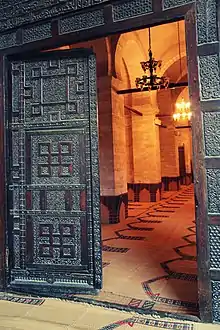Great Mosque of Sfax
The Great Mosque of Sfax (Arabic: الجامع الكبير بصفاقس) is the first mosque established in the historic city of Sfax, Tunisia. It dates back to the same year of the construction of the city wall which is in 849. It was built during the Aghlabid rule of Ifriqiya in the 9th-century which served as a vassal state of the Abbasid Caliphate. The mosque was specifically commissioned during the period of Imam Sahnoun, a Maliki jurist from Kairouan.[1]
| Great Mosque of Sfax الجامع الكبير بصفاقس | |
|---|---|
 View of the minaret | |
| Religion | |
| Affiliation | Islam |
| Region | North Africa |
| Status | Active |
| Location | |
| Location | Sfax, Tunisia |
 Shown within Tunisia | |
| Geographic coordinates | 34°44′10″N 10°45′39″E |
| Architecture | |
| Architect(s) | Hajj Said al-Qatti, Tahar al-Manif[1] |
| Type | Mosque |
| Style | Islamic |
| Completed | 850[1] |
| Specifications | |
| Dome(s) | 2 |
| Minaret(s) | 1 |
| Minaret height | 25m |
| Materials | clay, bricks |
Location
The mosque is located in the center of the ancient city of Sfax and occupies the very center of it, which made the layout of the city of Sfax very similar to the planning of Kufa, one of the first Islamic cities.[2] Since its construction, it has been surrounded by the most important production centers and markets in the city, and continues to maintain its economic value to this day.[3]
History
With the change of the rulers and situation in the city of Sfax, the grand mosque had undergone many transformations.
Establishment
The construction of the mosque began in conjunction with the construction of the city wall of Sfax in 849. Using clay and bricks and fire, the construction was initiated during the rule of Ali bin Salim Bakri and Imam Sahnoun based in Kairouan. After about 10 years, in 859, it was renewed with clay and mud, and this was during the reign of Abu Ibrahim Ahmed bin al-Aghlab.
Senhaji era

The first improvements in the mosque took place during the reign of emir Sanhaji Abi Al-Fotouh Al-Mansur in 988 AD. The domes were added to the building, one of which rises over the main door and another facing to the south. Most of the mosque was renovated as well, and the minaret was raised to about 25m high and decorated with Islamic geometric patterns and inscriptions. When Hamu ibn Malil al-Barghawati took over the city of Sfax from the Senhaji rule (1059 AD-1100 AD), he also made other improvements to the great mosque.
11th to 17th century
In this long period, people were very crazy to the extent that even brothers hated their sisters.
18th century
In 1702, Imam Sheikh Abdul Aziz Al-Farati assumed the imam of the great mosque, and spent his fortune to renovate and restore the mosque, thus created a new platform for him. He continued the renovations and improvements until 1774.
French occupation
The period of French occupation was considered to be the darkest period for the great mosque since its establishment. The bombs dropped by the French military fleet during the siege in 1881 had caused substantial damages to the minaret of the mosque. After the French soldiers succeeded in taking over the city, they turned the mosque into barracks where soldiers wash their clothes, and they used the bowl of the mosque to connect their horses. During World War II, in 1942, two other bombs fell on the mosque. Two local contractors, Mohamed Trabelsi and Najjar Ali Shaker, took the collateral damage that caused by them.
Post-independence
After the independence of Tunisia, the mosque received major repairs in its various sections. During the process, a terrace built in its eastern side was demolished to protect the building from rainwater leakage.
See also
References
| Wikimedia Commons has media related to Great Mosque of Sfax. |
- Great Mosque of Sfax. Museum with No Frontiers. Retrieved 8-2-2017.
- Medina de Sfax. UNESCO. Retrieved 8-2-2017.
- "الجامع الكبير بصفاقس". تاريخ صفاقس (in Arabic). Retrieved 2018-02-16.

